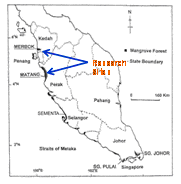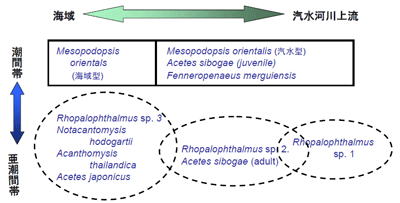Ecological characteristics of mangrove hyperbenthos in the northwest coast of Peninsular Malaysia
Description
Mangroves contribute substantially to coastal fishes as their nursery grounds by providing foods (Chong 2007). Hyperbenthic crustaceans, in particular Acetes and mysid (opossum) shrimps, are the food items frequently found in the stomach contents of various mangrove fishes of Peninsular Malaysia, indicating that these crustaceans play an important role in the estuarine food web by transferring the energy from lower producers towards higher consumers. However, the ecological traits of hyperbenthic crustaceans in mangrove estuaries of Southeast Asia have been poorly understood to date.
A year-round sledge net survey was conducted in the Matang and Merbok mangrove estuaries of the northwest coast of Peninsular Malaysia (Fig. 1) in order to clarify the species composition, biomass, and spatio-temporal variations. In addition, the reproductive biology and ecology of a dominant mysid, Mesopodopsis orientalis, were examined.
The biomass of infralittoral crustaceans in the Matang mangrove was about five times higher than that found in Merbok (p < 0.05). Although the crustacean biomass in the littoral zone of the Matang mangrove was underestimated due to the difficulty in accessing the sampling sites, coupled with a comparatively large amount of net avoidance by larger-sized crustaceans in the mangrove areas, the quantity of biomass in the surveyed mangroves was noticeably higher as compared with that found in the adjacent coastal waters without mangroves at southern Penang Island (p < 0.05) (Table 1).
Three species of Acetes shrimp and six species of mysids, representing the genera Rhopalophthalmus, Acanthomysis, Notoacanthomysis, and Mesopodopsis, constituted a substantial portion of hyperbenthic crustaceans. The spatial distribution pattern of these crustaceans was common in both the Merbok and Matang mangroves, and they have been shown to have species-specific habitats in the estuarine system (Fig. 2). Juveniles of Acetes sibogae, Fenneropenaeus merguiensis, and Mesopodopsis orientalis (covering all developmental stages) were collected exclusively along the water edge of the estuarine river close to the mangrove forest (intertidal zone). In the infralittoral zone, Acanthomysis s. l. , Rhopalophthalmus sp. 3, and Acetes japonicus predominated in the mouth of the estuarine river, while A. sibogae tended to increase in number towards the upper reaches, and Rhopalophthalmus sp. 2 occurred primarily in the middle reaches.
Mesopodopsis orientalis is actually one of the most important mysids in the coastal waters of Southeast Asia, and this was true in the surveyed estuaries. The recorded density in the Merbok mangrove (700 ind. /m-2 in annual mean) was the highest among those observed in the estuarine mysids worldwide. And again, the abundance in this estuary was more than ten times higher than that found in the related coastal waters, indicating high productivity in the Malaysian mangrove estuary.
The reproduction of the Malaysian shallow-water mysid, unlike temperate and subarctic mysids, was year-round, and the abundance and reproductive activity appeared to be unaffected by seasonality, or if present, very much reduced or only at a minimum. Relatively stable environmental condition, particularly water temperature, was assumed to contribute significantly to a less pronounced population dynamics of the crustaceans of this region. Interestingly, the mangrove population of M. orientalis was less fecund as compared with its coastal counterpart but was bigger in size during its entire life cycle stages (Fig. 3). A similar phenomenon has been observed in Japanese euryhaline prawns, and subsequent analyses have detected genetic differences among local populations with different life history characteristics. Hence, our finding strongly suggests that differences in the life history traits among the local populations of a mysid observed worldwide should be reassessed in terms of not only ecophysiological parameters but also genetic backgrounds.
Figure, table
-
Fig. 1. Study sites
(Merbok and Matang mangrove estuaries, Peninsular Malaysia) -
Fig. 2. Schematic representation of the spatial distribution of hyperbenthic crustaceans in mangrove estuaries
(Modified and extended from Hanamura et al., 2007a) -
-
- Affiliation
-
Japan International Research Center for Agricultural Sciences Fisheries Division
- Classification
-
Technical A
- Term of research
-
FY2006(FY2006~2011)
- Responsible researcher
-
HANAMURA Yukio ( 水産領域 )
KAKEN Researcher No.: 50371951Siow Ryon ( Fisheries Research Institute, Malaysia )
CHEE Phaik-Ean ( Fisheries Research Institute, Malaysia )
- ほか
- Publication, etc.
-
Hanamura, Y., Siow, R. and Chee, P.-E. (2007a): Abundance and spatio-temporal distributions of hyperbenthic crustaceans in the Merbok and Matang mangrove estuaries. Malaysia. JIRCAS Working Rep., 56: 35-41.
Sustainable Production Systems of Aquatic Animals in Brackish Mangrove Areas(2005)
Hanamura, Y., Siow, R. and Chee, P.-E. (2007b):Abundance and spatio-temporal distribution of Acetes shrimp (Crustacea, Sergestidae) in the Merbok and Matang mangrove estuaries, Peninsular Malaysia. Malaysian Fish. Journ., 6: 16-25.
Hanamura, Y., Siow, R. and Chee, P.-E. (2008): Reproductive biology and seasonality of the Indo-Australa- sian mysid Mesopodopsis orientalis in a tropical mangrove estuary, Malaysia. Estur. Coast. Shelf Sci., 77:467-474.
- Japanese PDF


